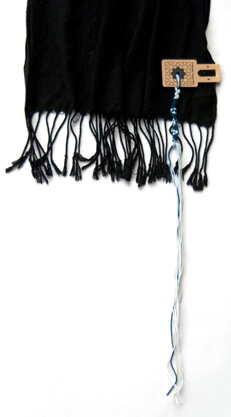Commissioned for the exhibition The Turks in Vienna at the Jewish Museum Vienna, the project Tempelmarke [Temple Tag] explores possibilities of activating history through the embodiment of memory. The exhibition explored the history of the Sephardic Jewish community of Vienna that officially existed under the protection of the Ottoman sultan. Its synagogue, designed in Moorish style and called Das Türkische Tempel [The Turkish Temple], was inaugurated in 1887 and destroyed by the Nazis in 1938. The project aims to remember this extraordinary synagogue through the use of small wearable objects called temple tags.
A temple tag is a hybrid of a prayer shawl (tallit) corner and a plastic admission tag that can be attached to clothes of museum visitors. The golden rectangular tag has a hole in its center, though which tzitzit threads (three white and one blue) are led. A simple geometrical pattern is printed on the visible surface of the tag, referencing Moorish/ Islamic geometry, Jewish symbolism, and a design element of the former Turkish Temple (i.e. patterns of the carpet). The tag is golden-metallic, reminiscent of the golden tiles that used to cover the interior dome of the synagogue. The tag occupies and transforms the visitor’s admission by combining it with the corner of a tallit, four of which can transform the visitors’ clothes into a Jewish prayer shawl. With this, the modular character of the work comes to the fore: while an individual tag stands for an admission mark of the museum, four temple tags can form the four corners of a tallit. Ten tallits worn by individuals form the basis for a minyan, representing an abstraction of a synagogue. Thus, the Tempelmarke marks the entrant as a bearer of a part of a Jewish prayer shawl and references the current existence of the synagogue as a ruin, existing only in pieces, in memory, dispersed as was the Turkish-Jewish community. In addition to the tag, the piece includes a video-text installation, which shows the process of knotting a Sephardic type of tzitzit, which informs the visitor about the Viennese synagogue’s history and part of the culture it housed.
Concept, design, and production: Azra Akšamija and Dietmar Offenhuber
Photographs: Azra Akšamija
Wearable device
Co-authored with Dietmar Offenhuber
Project commissioned by the Jewish Museum of Vienna for the exhibition The Turks in Vienna, curated by Felicitas Heinman- Jelinek, Gabriele Kohlbauer-Fritz and Gerhard Milchram.
Materials: 10,000 plastic admission tags, 1 video
Dimensions: Tags, 3.8 x 7.4 cm each; Video: single-channel, 10 min.
Also see: Akšamija, Azra, and Dietmar Offenhuber. “Tempelmarke.” In Die Türken in Wien. Die Geschichte einer Jüdischen Gemeinde, edited by Felicitas Heinman-Jelinek, Gabriele Kohlbauer-Fritz and Gerhard Milchram, 194–195. Vienna: The Jewish Museum, 2010.








